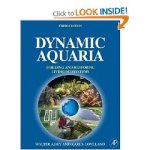eyrops
Member
Dynamic Aquaria: Building Living Ecosystems . Walter H. Adey and Karen Loveland, Acedemic Press, 1991.
This is a book that is useful reference both for hobbyists and those who develop and maintain aquaria as a profession. It does not have material specifically about keeping amphibians. Its strength is covering aquaria as model ecosystems. In doing this it provides a solid foundation for designing and operating many kinds of aquaria and larger systems. The authors experience at the Smithsonian gives authenticity and a unique perspective to the subject. They are interested in how physical chemical and biological components interact to form ecosystems, and in how these systems can be modeled. In designing a museum exhibit that is a model ecosystem, many problems are encountered and solved that have relevance to smaller systems too. We create little ecosystems that work or don’t work whether they are little Rubbermaid trays for one salamander, or 200 gallon aquariums, or something larger. For a hobbyist, the book expands the possible. It shows, for example, the design of a coral reef, but it also shows the design of a Maine rocky shore and a Florida everglades system. For someone who keeps amphibians I think it offers an opportunity to consider their home in a new light.
Here is a table of contents from the third (2007) edition:
This is a book that is useful reference both for hobbyists and those who develop and maintain aquaria as a profession. It does not have material specifically about keeping amphibians. Its strength is covering aquaria as model ecosystems. In doing this it provides a solid foundation for designing and operating many kinds of aquaria and larger systems. The authors experience at the Smithsonian gives authenticity and a unique perspective to the subject. They are interested in how physical chemical and biological components interact to form ecosystems, and in how these systems can be modeled. In designing a museum exhibit that is a model ecosystem, many problems are encountered and solved that have relevance to smaller systems too. We create little ecosystems that work or don’t work whether they are little Rubbermaid trays for one salamander, or 200 gallon aquariums, or something larger. For a hobbyist, the book expands the possible. It shows, for example, the design of a coral reef, but it also shows the design of a Maine rocky shore and a Florida everglades system. For someone who keeps amphibians I think it offers an opportunity to consider their home in a new light.
Here is a table of contents from the third (2007) edition:
- [FONT="]Introduction [/FONT]
- [FONT="]The Envelope: Physical Parameters and Energy State [/FONT]
- [FONT="]Substrate: The Active Role of Rock, Mud, and Sand [/FONT]
- [FONT="]Water Composition: Management of Salinity, Hardness, and Evaporation [/FONT]
- [FONT="]The Input of Solar Energy: Lighting Requirements [/FONT]
- [FONT="]The Input of Organic Energy: Particulates and Feeding [/FONT]
- [FONT="]Metabolism: Respiration, Photosynthesis, and Biological Loading [/FONT]
- [FONT="]Organisms and Gas Exchange: Oxygen, Carbon Dioxide, pH, and Alkalinity [/FONT]
- [FONT="]The Primary Nutrients - Nitrogen, Phosphorus, and Silica: Limitation and Eutrophication [/FONT]
- [FONT="]Biomineralization and Calcification: A Key to Biosphere and Ecosystem Function [/FONT]
- [FONT="]Control of the Biochemical Environment: Filters, Bacteria, and the Algal Turf Scrubber [/FONT]
- [FONT="]Community Structure: Biodiversity in Model Ecosystems [/FONT]
- [FONT="]Trophic Structure: Ecosystems and the Dynamics of Food Chains [/FONT]
- [FONT="]Primary Producers: Plants That Grow on the Bottom [/FONT]
- [FONT="]Herbivores: Predators of Plants and Omnivores, Predators of Plants and Animals [/FONT]
- [FONT="]Carnivores: Predators of Animals [/FONT]
- [FONT="]Plankton and Planktivores: Floating Plants and Animals and Their Predators [/FONT]
- [FONT="]Detritus and Detritivores: The Dynamics of Muddy Bottoms [/FONT]
- [FONT="]Symbionts and Other Feeders [/FONT]
- [FONT="]Models of Coral Reef Ecosystems [/FONT]
- [FONT="]A Subarctic/Boreal Microcosm: Test of a Biogeographic Model [/FONT]
- [FONT="]Estuaries: Ecosystem Modeling and Restoration: Where Fresh and Salt Waters Interact [/FONT]
- [FONT="]Freshwater Ecosystem Models[/FONT]
- [FONT="]Organisms and Natural Products: Commercial Ecosystem Culture [/FONT]
- [FONT="]Large Scale Water Quality Management with Solar Energy Capture [/FONT]
- [FONT="]Microcosms, Mesocosms, and Macrocosms: Building and Restoring Ecosystems: A Synthesis [/FONT]

